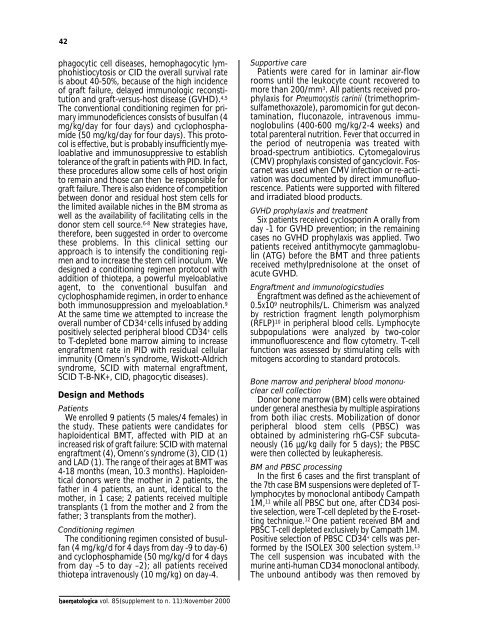Journal of Hematology - Supplements - Haematologica
Journal of Hematology - Supplements - Haematologica
Journal of Hematology - Supplements - Haematologica
You also want an ePaper? Increase the reach of your titles
YUMPU automatically turns print PDFs into web optimized ePapers that Google loves.
42<br />
phagocytic cell diseases, hemophagocytic lymphohistiocytosis<br />
or CID the overall survival rate<br />
is about 40-50%, because <strong>of</strong> the high incidence<br />
<strong>of</strong> graft failure, delayed immunologic reconstitution<br />
and graft-versus-host disease (GVHD). 4,5<br />
The conventional conditioning regimen for primary<br />
immunodeficiences consists <strong>of</strong> busulfan (4<br />
mg/kg/day for four days) and cyclophosphamide<br />
(50 mg/kg/day for four days). This protocol<br />
is effective, but is probably insufficiently myeloablative<br />
and immunosuppressive to establish<br />
tolerance <strong>of</strong> the graft in patients with PID. In fact,<br />
these procedures allow some cells <strong>of</strong> host origin<br />
to remain and those can then be responsible for<br />
graft failure. There is also evidence <strong>of</strong> competition<br />
between donor and residual host stem cells for<br />
the limited available niches in the BM stroma as<br />
well as the availability <strong>of</strong> facilitating cells in the<br />
donor stem cell source. 6-8 New strategies have,<br />
therefore, been suggested in order to overcome<br />
these problems. In this clinical setting our<br />
approach is to intensify the conditioning regimen<br />
and to increase the stem cell inoculum. We<br />
designed a conditioning regimen protocol with<br />
addition <strong>of</strong> thiotepa, a powerful myeloablative<br />
agent, to the conventional busulfan and<br />
cyclophosphamide regimen, in order to enhance<br />
both immunosuppression and myeloablation. 9<br />
At the same time we attempted to increase the<br />
overall number <strong>of</strong> CD34 + cells infused by adding<br />
positively selected peripheral blood CD34 + cells<br />
to T-depleted bone marrow aiming to increase<br />
engraftment rate in PID with residual cellular<br />
immunity (Omenn’s syndrome, Wiskott-Aldrich<br />
syndrome, SCID with maternal engraftment,<br />
SCID T-B-NK+, CID, phagocytic diseases).<br />
Design and Methods<br />
Patients<br />
We enrolled 9 patients (5 males/4 females) in<br />
the study. These patients were candidates for<br />
haploidentical BMT, affected with PID at an<br />
increased risk <strong>of</strong> graft failure: SCID with maternal<br />
engraftment (4), Omenn’s syndrome (3), CID (1)<br />
and LAD (1). The range <strong>of</strong> their ages at BMT was<br />
4-18 months (mean, 10.3 months). Haploidentical<br />
donors were the mother in 2 patients, the<br />
father in 4 patients, an aunt, identical to the<br />
mother, in 1 case; 2 patients received multiple<br />
transplants (1 from the mother and 2 from the<br />
father; 3 transplants from the mother).<br />
Conditioning regimen<br />
The conditioning regimen consisted <strong>of</strong> busulfan<br />
(4 mg/kg/d for 4 days from day -9 to day-6)<br />
and cyclophosphamide (50 mg/kg/d for 4 days<br />
from day –5 to day –2); all patients received<br />
thiotepa intravenously (10 mg/kg) on day-4.<br />
Supportive care<br />
Patients were cared for in laminar air-flow<br />
rooms until the leukocyte count recovered to<br />
more than 200/mm 3 . All patients received prophylaxis<br />
for Pneumocystis carinii (trimethoprimsulfamethoxazole),<br />
paromomicin for gut decontamination,<br />
fluconazole, intravenous immunoglobulins<br />
(400-600 mg/kg/2-4 weeks) and<br />
total parenteral nutrition. Fever that occurred in<br />
the period <strong>of</strong> neutropenia was treated with<br />
broad-spectrum antibiotics. Cytomegalovirus<br />
(CMV) prophylaxis consisted <strong>of</strong> gancyclovir. Foscarnet<br />
was used when CMV infection or re-activation<br />
was documented by direct immun<strong>of</strong>luorescence.<br />
Patients were supported with filtered<br />
and irradiated blood products.<br />
GVHD prophylaxis and treatment<br />
Six patients received cyclosporin A orally from<br />
day -1 for GVHD prevention; in the remaining<br />
cases no GVHD prophylaxis was applied. Two<br />
patients received antithymocyte gammaglobulin<br />
(ATG) before the BMT and three patients<br />
received methylprednisolone at the onset <strong>of</strong><br />
acute GVHD.<br />
Engraftment and immunologicstudies<br />
Engraftment was defined as the achievement <strong>of</strong><br />
0.5x10 9 neutrophils/L. Chimerism was analyzed<br />
by restriction fragment length polymorphism<br />
(RFLP) 10 in peripheral blood cells. Lymphocyte<br />
subpopulations were analyzed by two-color<br />
immun<strong>of</strong>luorescence and flow cytometry. T-cell<br />
function was assessed by stimulating cells with<br />
mitogens according to standard protocols.<br />
Bone marrow and peripheral blood mononuclear<br />
cell collection<br />
Donor bone marrow (BM) cells were obtained<br />
under general anesthesia by multiple aspirations<br />
from both iliac crests. Mobilization <strong>of</strong> donor<br />
peripheral blood stem cells (PBSC) was<br />
obtained by administering rhG-CSF subcutaneously<br />
(16 µg/kg daily for 5 days); the PBSC<br />
were then collected by leukapheresis.<br />
BM and PBSC processing<br />
In the first 6 cases and the first transplant <strong>of</strong><br />
the 7th case BM suspensions were depleted <strong>of</strong> T-<br />
lymphocytes by monoclonal antibody Campath<br />
1M, 11 while all PBSC but one, after CD34 positive<br />
selection, were T-cell depleted by the E-rosetting<br />
technique. 12 One patient received BM and<br />
PBSC T-cell depleted exclusively by Campath 1M.<br />
Positive selection <strong>of</strong> PBSC CD34 + cells was performed<br />
by the ISOLEX 300 selection system. 13<br />
The cell suspension was incubated with the<br />
murine anti-human CD34 monoclonal antibody.<br />
The unbound antibody was then removed by<br />
haematologica vol. 85(supplement to n. 11):November 2000

















